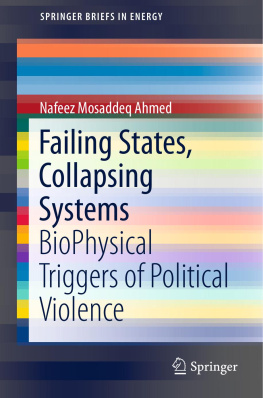Nafeez Mosaddeq Ahmed - Failing States, Collapsing Systems BioPhysical Triggers of Political Violence
Here you can read online Nafeez Mosaddeq Ahmed - Failing States, Collapsing Systems BioPhysical Triggers of Political Violence full text of the book (entire story) in english for free. Download pdf and epub, get meaning, cover and reviews about this ebook. year: 2016, genre: Politics. Description of the work, (preface) as well as reviews are available. Best literature library LitArk.com created for fans of good reading and offers a wide selection of genres:
Romance novel
Science fiction
Adventure
Detective
Science
History
Home and family
Prose
Art
Politics
Computer
Non-fiction
Religion
Business
Children
Humor
Choose a favorite category and find really read worthwhile books. Enjoy immersion in the world of imagination, feel the emotions of the characters or learn something new for yourself, make an fascinating discovery.
- Book:Failing States, Collapsing Systems BioPhysical Triggers of Political Violence
- Author:
- Genre:
- Year:2016
- Rating:3 / 5
- Favourites:Add to favourites
- Your mark:
- 60
- 1
- 2
- 3
- 4
- 5
Failing States, Collapsing Systems BioPhysical Triggers of Political Violence: summary, description and annotation
We offer to read an annotation, description, summary or preface (depends on what the author of the book "Failing States, Collapsing Systems BioPhysical Triggers of Political Violence" wrote himself). If you haven't found the necessary information about the book — write in the comments, we will try to find it.
Failing States, Collapsing Systems BioPhysical Triggers of Political Violence — read online for free the complete book (whole text) full work
Below is the text of the book, divided by pages. System saving the place of the last page read, allows you to conveniently read the book "Failing States, Collapsing Systems BioPhysical Triggers of Political Violence" online for free, without having to search again every time where you left off. Put a bookmark, and you can go to the page where you finished reading at any time.
Font size:
Interval:
Bookmark:
Failing States,
Collapsing Systems
BioPhysical Triggers of Political Violence 123
SpringerBriefs in Energy
Energy Analysis
Charles Hall
College of Environmental, SUNY ESF, Syracuse, NY, USA
More information about this series at http://www.springer.com/series/10041
Nafeez Mosaddeq Ahmed
Failing States, Collapsing Systems BioPhysical Triggers of Political Violence
Nafeez Mosaddeq Ahmed
Global Sustainability Institute Anglia Ruskin University Cambridge , UK
ISSN 2191-5520
ISSN 2191-5539
(electronic)
SpringerBriefs in Energy
ISBN
978-3-319-47814-2
ISBN
978-3-319-47816-6 (eBook)
DOI 10.1007/978-3-319-47816-6
Library of Congress Control Number: 2016955192
The Author(s) 2017
This work is subject to copyright. All rights are reserved by the Publisher, whether the whole or part of the material is concerned, specifi cally the rights of translation, reprinting, reuse of illustrations, recitation, broadcasting, reproduction on microfi lms or in any other physical way, and transmission or information storage and retrieval, electronic adaptation, computer software, or by similar or dissimilar methodology now known or hereafter developed.
The use of general descriptive names, registered names, trademarks, service marks, etc. in this publication does not imply, even in the absence of a specifi c statement, that such names are exempt from the relevant protective laws and regulations and therefore free for general use.
The publisher, the authors and the editors are safe to assume that the advice and information in this book are believed to be true and accurate at the date of publication. Neither the publisher nor the authors or the editors give a warranty, express or implied, with respect to the material contained herein or for any errors or omissions that may have been made.
Printed on acid-free paper This Springer imprint is published by Springer Nature
The registered company is Springer International Publishing AG
The registered company address is: Gewerbestrasse 11, 6330 Cham, Switzerland Contents
Introduction .............................................................................................
The Crisis of Civilization as an Analytical Framework ......................
2.1 The Human-Environment System as a Complex Adaptive System ..............................................................................
2.2
The Energy Metabolism of Human Civilization ..............................
2.3
The Physics of System Failure .........................................................
Net Energy Decline .................................................................................
3.1
The Decline of Conventional Oil .....................................................
3.2 The Rise and Decline of Unconventional Oil and Gas ....................
3.3
The Rise and Decline of Shale Gas ..................................................
3.4
The Decline of Coal and Uranium ...................................................
3.5
Peak and Terminal Decline of Net Energy .......................................
Permanent Secular Stagnation ..............................................................
4.1
Empirical Blindspots of Economic Theory ......................................
4.2
Economy as Embedded in Energy ...................................................
4.3
Plateau and Decline of Economic Growth .......................................
4.4
The Mythology of Decoupling .........................................................
Earth System Disruption ........................................................................
5.1
Ocean Acifi cation .............................................................................
5.2
Heat Waves .......................................................................................
5.3
Food Production ...............................................................................
Human System Destabilization ..............................................................
6.1
Intrastate Violence ...........................................................................
6.2
Civil Unrest ......................................................................................
6.3
Militarization ....................................................................................
6.4
Terrorism ..........................................................................................
v
vi
Contents
Biophysical Triggers of Crisis Convergence in the Middle East ........
7.1
From Syria to Iraq ..........................................................................
7.2
Yemen ............................................................................................
7.3
Is Saudi Arabia Next? ....................................................................
7.4
The New Normal ............................................................................
Biophysical Triggers of Crisis Convergence in Africa .........................
8.1
Behind Boko Haram in Nigeria .....................................................
8.2
Regime Rotation in Egypt ..............................................................
8.3
Authoritarian Turn .........................................................................
Biophysical Triggers of Crisis Convergence in Asia ............................
9.1
The End of the Indian dream .........................................................
9.2
China: Paper Tiger .........................................................................
9.3
Arrested Development ...................................................................
in the Euro-Atlantic Core .......................................................................
10.1
Europe ............................................................................................
10.2
North America ...............................................................................
10.3
Post-20302045 .............................................................................
to Civilizational Transition .....................................................................
11.1
Global Phase-Shift .........................................................................
11.2
Clean Energy and Environmental Restoration ...............................
11.3
Circular Economy and Post-Capitalism .........................................
11.4
Information Revolution and Social Liberation ..............................
11.5
A New Action-Research Agenda ...................................................
Bibliography ....................................................................................................
Index ................................................................................................................. 107
Font size:
Interval:
Bookmark:
Similar books «Failing States, Collapsing Systems BioPhysical Triggers of Political Violence»
Look at similar books to Failing States, Collapsing Systems BioPhysical Triggers of Political Violence. We have selected literature similar in name and meaning in the hope of providing readers with more options to find new, interesting, not yet read works.
Discussion, reviews of the book Failing States, Collapsing Systems BioPhysical Triggers of Political Violence and just readers' own opinions. Leave your comments, write what you think about the work, its meaning or the main characters. Specify what exactly you liked and what you didn't like, and why you think so.











